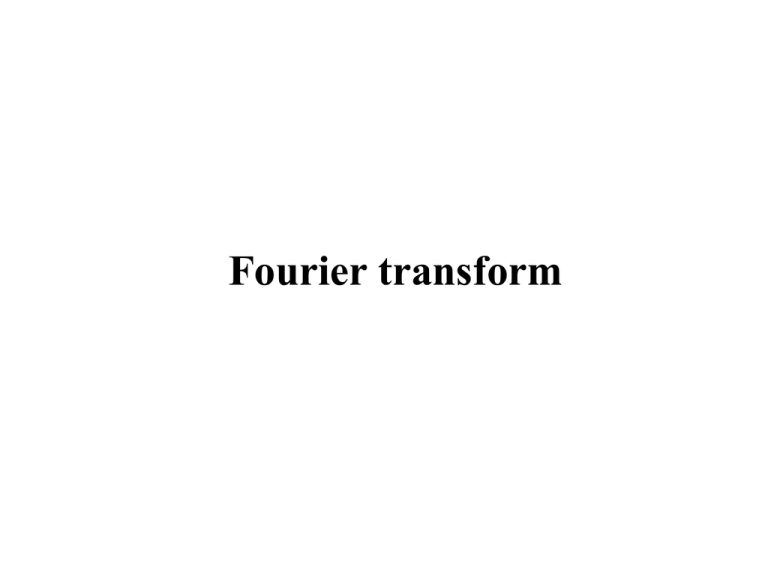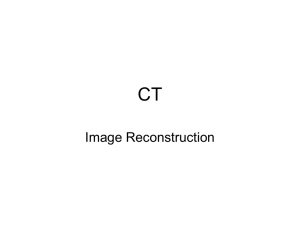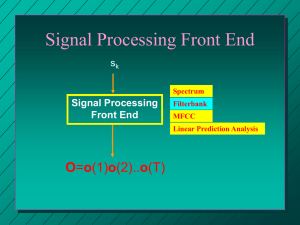CH2_1 fourie transform
advertisement

Fourier transform
Response of Linear Shift-Invariant
System
h(t)
Input
Output
h(t)
t
Input
t
e j 2ft
System
System
h(t- )
t
Output
H(f)
t
H ( f )e j 2ft
Mathematical tool for Signal Analysis of
Linear System
• The mathematical tool that relates the frequencydomain description of the signal to its time-domain
description is the Fourier transform.
• The continuous Fourier transform, or the Fourier
transform (FT) for short.
• The discrete Fourier transform, or DFT for short.
Temporal Fourier Transform
Th e fu n ctiong ( t ) satisfie th
s e Dirichlet's condition.
Th e fu n ctiong ( t ) i s sin gle- valu e d,with a fin iten u m be rof m axim aan dm in im ai n
an y fin itetim ein te rval.
Th e fu n ctiong ( t ) h asa fin iten u m be rof discon tin itie
u si n an y fin itetim ein te rval.
Th e fu n ctiong ( t ) i s absolu te lyin te rgrabl
e | g ( t ) | dt
De fin ition
of Fou rie rtran sform:
G( f )
g(t ) e xp( j 2ft )dt
G ( f ) F[ g ( t )]
In ve rseFou rie rtran sform:
g( t )
G( f ) e xp(j 2ft )df
g( t ) F -1 [G ( f )]
g( t ) G ( f )
C on tin u ouspe
s ctru m
G ( f ) | G ( f ) | e xp[j ( f )]
C on tin u ouam
s plitu despe ctru m: | G ( f ) || G ( f ) | (e ve nfu n ction )
C on tin u ouph
s asespe ctru m: ( f ) ( f ) (odd fu n ction )
Sketch of the interplay between the synthesis and analysis
equations embodied in Fourier transformation.
Properties of The Fourier Transform
Lin e arity: Le t g1 ( t ) G1 ( f ) an d g 2 ( t ) G2 ( f ), th e nc1 g1 ( t ) c2 g2 ( t ) c1 G1 ( f ) c2 G2 ( f )
Dilation: Le t g( t ) G ( f ), th e ng(at)
1
f
G( )
|a| a
C on ju gatio
n : Le t g( t ) G ( f ), th e ng * ( t ) G * (- f ) an d g * ( t ) G * ( f )
Du lity: Le t g ( t ) G ( f ), th e nG ( t ) g( f )
Tim e sh iftin g: If g ( t ) G ( f ), th e ng( t t 0 ) G ( f ) e xp( j 2ft 0 )
Fre qu e n cysh iftin g: If g( t ) G ( f ), th e ne xp(j 2f c t ) g ( t ) G ( f f c )
Are au n de rg ( t ) : If g( t ) G ( f ), th e n g ( t )dt G (0)
-
Are au n de rG ( f ) : If g( t ) G ( f ), th e ng (0) G ( f )df
-
d
Diffe re n ti
on in th e tim edom ai n: G ( f ) : Le t g( t ) G ( f ), th e n g ( t ) j 2fG ( f )
dt
dn
n g ( t ) ( j 2f ) n G ( f )
dt
In te gratio
n in th e tim edom ai n: G ( f ) : Le t g( t ) G ( f ) an dG (0) 0 , th e n g( )d
t
-
1
G( f )
j 2f
Properties of The Fourier Transform
Line arity: Le t g1 ( t ) G1 ( f ) and g2 ( t ) G2 ( f ), the nc1 g1 ( t ) c2 g2 ( t ) c1 G1 ( f ) c2 G2 ( f )
F {c1 g1 ( t ) c2 g2 ( t )}
-1
c G ( f ) e xp(j 2ft )df c G ( f ) e xp(j 2ft )df
1
1
2
2
c1 G1 ( f ) e xp(j 2ft )df c2 G2 ( f ) e xp(j 2ft )df
c1F -1 { g1 ( t )} c2F -1 { g2 ( t )}
Dil ationprope rty:
g( t ) G ( f )
G( f )
g(t ) e xp( j 2ft )dt
i. a 0
1
f
1
f
F[ g (at)] g (at) e xp( j 2ft )dt g ( ) e xp( j 2 )d G ( )
a
a
a
a
i. a 0
1
f
1
f
F[ g (at)] g (at) e xp( j 2ft )dt g ( ) e xp( j 2 )d G ( )
a
a
a
a
1
f
G( )
|a| a
a -1 F[ g ( t )] G ( f )
F[ g (at)]
C on gu gateru l e:
g( t ) G ( f )
g( t )
G( f ) e xp(j 2ft )df
g (t )
*
*
g (t ) G ( f )
*
G ( f ) e xp( j 2ft )df G ( f ) e xp(j 2ft )df G ( f ) e xp(j 2ft )df
*
*
g* ( t ) G * ( f )
*
Du lityprope rty:
g( t ) G ( f ) an d g( t ) G ( f )
g( t )
G( f ) e xp(j 2ft )df G( f ) e xp( j 2ft )df G( f ) e xp( j 2ft )df
g( f )
G(t ) e xp( j 2ft )dt
Tim e sh iftin gprope rty:
g( t ) G ( f ) an d g ( t t 0 ) G ( f ) e xp( j 2ft 0 )
F [ g( t t 0 )]
g( t t
0
) e xp( j 2ft )dt e xp( j 2ft 0 ) g( ) e xp( j 2f )dt e xp( j 2ft 0 )G ( f )
Fre qe u n cysh iftin gprope rty:
F [e xp(j 2f c t ) g( t )]
g(t ) e xp[ j 2t ( f f
c
)]df G ( f f c )
Properties of The Fourier Transform
Modu lationTh e rom: Le t g1 ( t ) G1 ( f ) an d g 2 ( t ) G2 ( f ),
th e ng1 ( t ) g 2 ( t ) G1 ( )G2 ( f )d
-
g1 ( t ) g 2 ( t ) G1 ( f ) G2 ( f ) an d G1 ( f ) G2 ( f ) G2 ( f ) G1 ( f ) [ com m u tativ
e]
C on volu tio
n th e rom: Le t g1 ( t ) G1 ( f ) an d g 2 ( t ) G2 ( f ),
th e n g1 ( ) g 2 ( t )d G1 ( f )G2 ( f )
-
g1 ( t ) g 2 ( t ) G1 ( f )G2 ( f )
Th e com m u tativ
e prope rty: g1 ( t ) g 2 ( t ) g 2 ( t ) g1 ( t )
Th e associativ
e prope rty: g1 ( t ) [ g 2 ( t ) g 3 ( t )] [ g1 ( t ) g 2 ( t )] g3 ( t )
g1 ( t ) [ g 2 ( t ) g 3 ( t )] [ g1 ( t ) g2 ( t )] g 3 ( t ) G1 ( f )G2 ( f )G3 ( f )e j 2ft df
-
Th e distibu tiv
e prope rty: g1 ( t ) [ g 2 ( t ) g 3 ( t )] g1 ( t ) g 2 ( t ) g1 ( t ) g3 ( t )
C orre latio
n th e rom: Le t g1 ( t ) G1 ( f ) an d g 2 ( t ) G2 ( f ),
th e n g1 ( t ) g 2* ( t )dt G1 ( f )G2* ( f )
-
-
-
Rayle ighs'e n e rgyth e rom: g( t ) G ( f ), th e n | g( t ) |2 dt | G ( f ) |2 df
Modu lati onTh e rom: Le t g1 ( t ) G1 ( f ) an d g 2 ( t ) G2 ( f ),
th e ng1 ( t ) g 2 ( t ) G1 ( )G2 ( f )d G1 ( f ) G2 ( f )
-
g (t ) g (t ) e xp( j 2tf )dt
G12 ( f )
1
2
g2 (t )
G ( f ' ) e xp(j 2tf ' )df '
2
G12 ( f )
g (t )G ( f ' ) e xp[ j 2t ( f f ' )]df ' dt
1
2
f f'
G12 ( f )
G ( f )[ g (t ) e xp( j 2t )dt]d
2
1
G1 ( )G2 ( f )d
-
C on volu tio
n th e rom: Le t g1 ( t ) G1 ( f ) an d g 2 ( t ) G2 ( f ),
th e n g1 ( ) g 2 ( t )d G1 ( f )G2 ( f )
-
g1 ( t ) g 2 ( t ) G1 ( f )G2 ( f )
G ( f )G ( f ) e xp(j 2ft )df
1
2
G ( f ) g (t ' ) e xp( j 2ft ' )dt' e xp(j 2ft )df
1
2
G ( f ) g (t ' ) e xp[j 2f (t t ' )]dt'df
1
2
G ( f ) g (t ) e xp(j 2f )d df
1
2
g (t ) G ( f ) e xp(j 2f )df d
2
1
g (t ) G ( f ) e xp(j 2f )df d
2
1
g (t ) g (t )d
1
2
(t t' )
C orre latio
n th e rom: Le t g1 ( t ) G1 ( f ) an d g 2 ( t ) G2 ( f ),
th e n g1 ( t ) g 2* (t - )dt G1 ( f )G2* ( f )
*
G
(
f
)
G
( f ) e xp(j 2f )df
1
2
*
G
(
f
)[
g
(
'
)
e
xp(
j
2
f
'
)
d
'
]
e xp(j 2f )df
1
2
*
G
(
f
)
g
1
2
( ' ) e xp(j 2f ' )d ' e xp(j 2f )df
*
G
(
f
)
g
( ' ) e xp[j 2f ( ' )]d 'df ( ' t )
1
2
*
G
(
f
)
g
1 2 (t - ) e xp[j 2ft ]dtdf
g (t - ){ G ( f ) e xp[j 2ft ]df }dt
*
2
1
*
g
(
t
)
g
1 2 (t - )dt
Rayle ighs'e n e rgyth e rom: g ( t ) G ( f ),
-
-
th e n | g ( t ) |2 dt | G ( f ) |2 df
-
-
g ( t ) g * ( t )dt G ( f )G * ( f ) | G ( f ) |2
g ( t ) g * ( t )dt | G ( f ) |2 e xp(j 2f )df
-
0
| g ( t ) | dt | G ( f ) |2 df
-
2
-
Properties of The Fourier Transform
Th e com m utativ
e prope rty: g1 ( t ) g2 ( t ) g2 ( t ) g1 ( t )
g1 ( t ) g2 ( t )
g ( ) g (t )d
1
2
g1 ( ' t ) g2 ( ' )d '
g (t ' ) g ( ' )d '
1
2
g ( ' ) g (t ' )d '
2
1
g2 ( t ) g1 ( t )
Sim ilarly,
G1 ( f ) G2 ( f ) G2 ( f ) G1 ( f )
Properties of The Fourier Transform
e prope rty: g1 ( t ) [ g 2 ( t ) g 3 ( t )] [ g1 ( t ) g 2 ( t )] g 3 ( t )
Th e associativ
g1 ( t ) [ g 2 ( t ) g 3 ( t )] [ g1 ( t ) g 2 ( t )] g 3 ( t ) G1 ( f )G2 ( f )G3 ( f )e j 2ft df
-
pf :
g1 ( t ) [ g 2 ( t ) g 3 ( t )]
g1 ( t ) g4 ( t )
G1 ( f )G4 ( f )e j 2ft df
-
G1 ( f )[G2 ( f )G3 ( f )]e j 2ft df
-
[G1 ( f )G2 ( f )]G3 ( f )e j 2ft df
-
G5 ( f )G3 ( f )e j 2ft df
-
g5 ( t ) g 3 ( t )
[ g1 ( t ) g 2 ( t )] g 3 ( t )
Th e distibu tiv
e prope rty: g1 ( t ) [ g 2 ( t ) g 3 ( t )] g1 ( t ) g 2 ( t ) g1 ( t ) g 3 ( t )
pf :
g1 ( t ) g 2 ( t ) g1 ( t ) g 3 ( t )
[G1 ( f )G2 ( f ) G1 ( f )G3 ( f )]e j 2ft df
-
G1 ( f )[G2 ( f ) G3 ( f )]e j 2ft df
-
g1 ( t ) [ g 2 ( t ) g 3 ( t )]
Dirac Delta Function
■ Dirac delta function definition
-
-
(t )dt 1
-
g (t ) (t t0 )dt g (t0 )
g ( ) (t )d g (t ) g (t ) (t ) g (t )
F{ (t )} (t ) exp( j 2ft )dt
-
F{ (t )} 1
(t ) 1
G(f)
g(t)
(t)
0
1
t
f
■ Dirac delta function properties
-
-
a. ( t )dt ( t )dt 1
a
f ( t ) ( t a )dt f ( t ) ( t a )dt f (a )
-
a
if a 0,
-
f ( t ) ( t )dt f (0)
(t)
F { ( t )} ( t ) e xp( j 2ft )dt 1
-
F 1 { ( f )} ( f ) e xp(j 2ft )df 1
t
ε- ε+
-
F {1} 1 e xp( j 2ft )dt ( f )
-
-
f ( t ) (bt )dt
(bt )
1
b
b
-b
1
f ( ) ( )d f (0)
b
b
(t )
f (t)
f (a)
t
|b|
b. f ( ) ( x a )d f ( x a )
-
f ( x) ( x a) f ( x a)
a
Fourier transforms of Periodic Signals
gT0 ( t )
c
n
n
e xp(j 2nf 0 t ), an d cn
T0 / 2
g
T0 / 2
T0
( t ) e xp( j 2nf 0 t )dt
wh e recn i s th ecom ple xFou rie rcoe fficie ent,de fin e dby
an d f 0 i s th efu n dam e n ta
l fre qu e n cyde fin e das th ere ciprocalof th epe riodT0
1
T0
; th ati s f 0
T0
T0
g
(
t
),
f
0
g ( t ) T0
2
2
0,
e lse wh e re
gT0 ( t )
g(t mT )
0
m
Re writeth ecoe fficie tn: cn
g(t ) e xp( j 2nf t )dt
0
f 0G ( nf 0 )
gT0 ( t ) f 0
G(nf
n
0
) e xp(j 2nf 0 t ), an d g ( t mT0 ) f 0
g(t mT ) f G (nf
m
m
0
0
n
0
) ( f nf 0 )
G (nf
n
0
) e xp(j 2nf 0 t )
Dirac Comb Function
T (t )
0
G(nf
m
0
) ( t mT0 )
(t mT ), whe rele tG(nf
m
(t mT ) f ( f nf
m
0
0
0
n
0
)
g(t)
G(f)
g( t mT0 ) f 0 e xp(j 2nf 0 t )
m
n
T e xp(j 2nf t ) f
0
0 ( f nf 0 )
0
n
0
) 1 for all n
Example
1.DCsignal: e xp( j 2ft )dt (f) 1 (f)
-
g(t)
G(f)
1
(f)
t
0
f
2.C omple xe xpone tial
function: e xp(j 2f c t ) (f f c )
-
e xp(j 2f c t ) e xp( j 2ft )dt e xp 2 ( f f c )tdt (f f c )
-
G(f)
0
(f-fc)
f
fc
3.S in usoid
al fu n ction:
1
cos
(
2
f
t
)
[e xp(j 2f c t ) e xp( j 2f c t )]
c
2
sin( 2f c t ) 1 [e xp(j 2f c t ) e xp( j 2f c t )]
2j
1
cos
(
2
f
t
)
[(f f c ) (f f c )]
c
2
sin( 2f c t ) 1 [(f f c ) (f f c )]
2j
4.S ign u mfu nction:
e xp(-at),t 0
g(t)
0, t 0
e xp(at),t 0
F{ g(t)} G(f)
1, t 0
sgn(t ) limg(t) sgn(t ) 0, t 0
a0
1, t 0
j 4f
a 2 ( 2f ) 2
F{sgn(t ) }
1
jf
5.Unitste pfunction:
u(t)
1, t 0
1
, t0
2
0, t 0
1
1 1
u(t) [sgn(t ) 1] u(t) [
( f )]
2
2 jf
6.Inte grat
ion in th e tim edom ain
t
y( t )
g( )d
y( t )
u(t )
t
g( )d
g( )u(t ) d
1, τ t
1
, τt
2
0, τ t
Y ( f ) G ( f )[
1
1
G ( f ) G (0) ( f )
j 2f
2
1
( f )
1
1
]
G ( f ) G (0) ( f )
j 2f
2
j 2f
2
Problem 1
g(t)=rect(t)
1.Re ctagu l arfu n ction
1
1
,
|
t
|
2
rce t( t )
0 , | t | 1
2
t
1/ 2
-
-1 /2
F{rce t( t )} e xp[ j 2ft ]dt
e xp[ j 2ft ]dt
1 /2
e xp[ j 2ft ]
si nf
si nc( f )
j 2f
f
-1 /2
Th at i s as
G(f)=sinc(f)
rce t( t ) si nc( f )
t 1
1
,
|
|
t
a 2
If rce t( )
a
0 , | t | 1
a 2
t
th e n re ct( ) a si nc(a f )
a
f
Problem 2
(t )
2.Trian glefu n ction
1 | t | , | t | 1
(t )
, | t | 1
0
( t ) re ct( t ) re ct( t )
F{ ( t )} si nc 2 ( f )
t
t
1
t
( ) ( ) * ( )
a
a a
a
t
F{ ( )} a si nc 2 (af )
a
t
G(f)=sinc2(f)
f
Problem 3
3. Sinc pulse function
g( t ) A si nc( 2Wt )
G ( f ) F{ g ( t )}
A
f
rect(
)
2W
2W
Problem 4
4. Radio frequency (RF) pulse function
t
g ( t ) re ct( ) cos(2f c t )
T
T
G ( f ) F{ g ( t )} [si n c(T ( f f c )) si n c(T ( f f c ))]
2
Problem 5
5.S h ahfu n ction C
( om bfu n ction ,S am plefu n ction )
( t ) com b( t ) ( t n)
f
F{com b( t )} com b( )
a
g s ( t ) g( t ) ( t )
(t 1)
-3
-2
(t ) (t 1) ( t 2)
-1
0
3
2
1
4
t
g(t )
g s (t )
t
-3
-2
-1
0
1
2
3
Problem 6
6. S te pan dre pe atfu n ction
R( t ) g ( t ) ( t )
R( t )
g(t ' )(t t ' )dt'
n
g(t ' ) (t t ' n)dt'
g ( t n)
n
g(t 1)
-1
-1
0
1
=
g(t )
-2
g(t )
-1
g(t 1)
t
0
1
R( t ) g( t ) M ( t )
Fourier Transform Table
Function
G(f)
g(t)
( f )
f
1
f
sinc( f )
f
2
1 ( 2f ) 2
f
Function
G(f)
g(t)
exp(f 2 )
f
se ch(f )
f
exp(j / 4) exp(t 2 )
f
sin(Mf )
sin(f )
f
(t m )
m
f
The Inverse Relationship Between Time
and Frequency
The time-domain and frequency-domain descriptions of a signal are inversely
related to each other.
A signal cannot be strictly limited in both time and frequency.
The bandwidth of a signal provides a measure of the extent of the significant
spectral content of the signal for positive frequencies.
When the spectrum of a signal is symmetric with a main lobe bounded by welldefined nulls (i.e., frequencies at which the spectrum is zero).
A rectangular pulse of duration T seconds has a main spectral lobe of total width
(2/T) hertz centered at the origin.
The bandwidth of this rectangular pulse is (1/T) hertz.
The definition of bandwidth is called the null-to-null bandwidth.
•
•
Another popular definition of bandwidth is the 3-db bandwidth.
Yet another measure for the bandwidth of a signal is the root
mean-square (rms) bandwidth.
•
The rms bandwidth of a low-pass signal g(t) with Fourier
transform G(f)
Time-Bandwidth Product
(duration) × (bandwidth) = constant
•
The rms duration of the signal g(t) is
Numerical Computation of the Fourier Transform
The fast Fourier transform algorithm is itself derived from the discrete Fourier
transform, both time and frequency are represented in discrete form.
The discrete Fourier transform provides an approximation to the Fourier
transform.
If the samples are uniform spaced by Ts seconds, the spectrum of the signal
becomes periodic, repeating every fs=1/Ts Hz. Let N denote the number of
frequency samples contained in an interval fs.
Hence, the frequency resolution involved in the numerical computation of the
Fourier transform is defined by
f
fS
1
1
N NTS T
where T = NTs is the total duration of the signal.
Interpretations of the DFT and the IDFT
The discrete Fourier transform (DFT) of the sequence gn:
Consider then a finite data sequence {g0, g1,…..,,gN-1} which can represent the
result of sampling an analog signal g(t) at times t=0, Ts…, (N-1)Ts, where Ts is the
sampling interval.
gn g(nTS ) { g0, g1, .........., gN 1 } { g(0), g(1).........., g( N 1)}
N 1
Gk gn e xp(
n 0
j 2
kn),
N
k 0,1,.....,N 1
The sequence {G0, G1,…GN-1} is called the transform sequence. The inverse discrete Fourier
transform (IDFT) of Gk:
1
gn
N
N 1
Gk e xp(
k 0
j 2
kn),
N
n 0,1,.....,N 1
■The DFT as an analyzer of the data sequence gn
e xp(
j 2
2
2
2
2
kn) cos( kn) j sin( kn) {cos( kn), sin( kn)}
N
N
N
N
N
k 0,1,.....,N 1
■ The IDFT as a synthesizer of gn
Fast Fourier Transform Algorithms
FFT algorithms are computationally efficient because they use a greatly reduced
number of arithmetic operations as compared to brute force computation of the
DFT.
An FFT algorithm attains its computational efficiency by following a divide-andconquer strategy, whereby the original DFT computation is decomposed
successively into smaller DFT computations.
Gk
N 1
g W
n 0
n
W e xp(
nk
,
k 0,1,.....,N 1
j 2
j 2
j 2 N
),W N e xp(
N ) 1, and W N / 2 e xp(
) 1
N
N
N 2
Gk
N 1
g W
nk
n
n 0
N / 2 1
gnW
nk
n 0
N / 2 1
g W
n
n 0
nk
N / 2 1
N 1
g W
n N / 2
gn N / 2W
( n N / 2 ) k
n 0
nk
n
N / 2 1
Nk / 2
nk
(
g
g
W
)
W
n n N / 2
n 0
For e ve nk , k 2l , an d x n g n g n N / 2
G2 l
N / 2 1
x
n 0
n
(W 2 ) nl
, l 0,1,.....,N / 2 1
For odd k , k 2l 1, an d yn g n g n N / 2
G2 l 1
N / 2 1
n 0
ynW
( 2 l 1 ) nl
N / 2 1
n 0
ynW nW ( 2 )
nl
, l 0,1,.....,N / 2 1
The coefficient Wn multiplying yn is called a twiddle factor.
Computation for The Data Sequence
A signal-flow graph consists of an interconnection of nodes and branches. The
direction of signal transmission along a branch is indicated by an arrow.
A branch multiplies the variable at a node by the branch transmittance.
. 4-point DFT into two 2-point DFTs
8-point DFT into two 4-point DFTs
Trivial case of 2-point DFT
Decimation-in-frequency FFT algorithm.
•
The FFT algorithm is referred to as a decimation-in-frequency algorithm,
because the transform (frequency) sequence Gk, is divided successively
into smaller subsequences. In another popular FFT algorithm, called a
decimation-in-time algorithm, the data (time) sequence gn is divided
successively into smaller subsequences.
P.88
P.88








